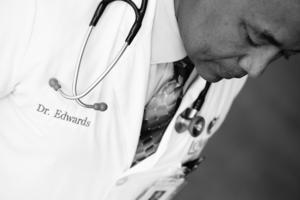![]() EXPERT
EXPERT
Dr. Ivan Edwards, D.O.
Physiatrist (Physical Medicine) | Physical Medicine & Rehabilitation
He is the CEO and owner of JOVANA Rehabilitation Medicine & Pain. He is also a military veteran, currently and proudly serving as a USAF Reserve Flight Surgeon, at the rank of Lt. Colonel.
Dr. Edwards is an expert in the areas of medical rehabilitation, musculoskeletal medicine, and comprehensive pain management. As a PM&R specialist, he sees patients who have had trauma, injury, or have musculoskeletal and/or neurological disorders, including low back, joint and extremity pain. He is a member of multiple organizations, including the Aerospace Medical Association, the Texas Medical Association, the Military Officers Association of America, and the Society of USAF Flight Surgeons. He also sits on a few hospital medical executive board committees.
Dr. Edwards has assisted in numerous court cases pertaining to injuries, trauma and rehabilitation.
He is a public speaker, both locally and internationally.
Firsts:
Dr. Ivan Edwards is the first flight surgeon of Ugandan descent.
He is the first Ugandan American to be honored as a Kentucky Colonel.
- San Antonio, TX, TX
- East Virginia Medical School
- Accepting new patients
The Danger of Unqualified Health Advice in the Digital Age
In the age of digital connectivity, the abundance of health advice can feel like both a blessing and a curse. Social media platforms, blogs, and podcasts have made it easier than...
From injury to triumph: Amanda's unyielding spirit
In the blink of an eye, everything changed. On an ordinary day in September 2001, 16-year-old Amanda's life was dramatically changed. That evening, a catastrophic motor vehicle...
Why depression, anxiety, and chronic pain worsen during hard economic times
When the economy struggles, it doesn’t just hit your wallet—it can impact your emotional and physical health, too. During times of financial hardship, you might notice your depression...
Arthritis pain
Understanding ArthritisArthritis isn’t just one condition—it’s a family of diseases that affects millions of people worldwide. From the unavoidable aches of wear and tear to the...
Your loved ones know your list…
I’ll never forget the day when I received a call that impacted me greatly. It was early in the morning, and I was doing my rounds in a healthcare facility. The head nurse urgently...
In Search For a Better Way...
Pills, medicines, and more medicines. They may tame diseases, but they don’t solve the problem. They may suppress the symptoms, but they do not address the root causes of diseases....
6 Reasons You Should Go On A Plant-Based Diet
Like we all intrinsically desire, you want to live a healthy and better life. A life well lived serves a purpose. Getting sick is undesirable; it robs your joy, peace, and purpose....
Can a stroke patient recover from paralysis?
Location
a) the location of the impacted part of the brain or spinal cord that the stroke is associated with. If, for example, the stroke arises in the motor area of the brain versus the sensory part--the paralysis will be more pronounced and longer lasting
Rehabilitation
b) Rehabilitation would be critical to restore recovery. If one does not participate in rehabilitation, the paralysis would persist or evolve into spasticity and contracture--and into more serious disability.
Compliance with treatment and therapy
3. Failure to comply with the appropriate treatment and therapy would limit the appropriate recovery from paralysis.
How to keep my knee from popping out of place?
This condition most commonly affects women.
It occurs from a twisting mechanism with the knee in extension, or with encounter of a direct hit to the knee cap.
Some of the proven ways to prevent the knee for popping out of place is to do the following:
a) taping or bracing - to prevent the de-tracking mechanism
b) orthotic device - to stabilize the tracking mechanism over time
c) quad strengthening - to support the appropriate tracking mechanism
Repeated subluxations (incomplete pop outs) or dislocations (complete pop outs) can further be assessed via imaging, to ensure that no ligaments or tissue destruction have occurred to precipitate the repeated dysfunction.
How long does it take to get strength back after COVID?
It can take up to 6 months, following the illness, for the patient to regain strength (1). Generally, it is safe to postulate that the length of time it takes to regain one's strength after having COVID-19 depends on the severity of the illness one went through.
Source
1. https://www.ncbi.nlm.nih.gov/pmc/articles/PMC7833295/
What rehabilitation is needed after a stroke?
Rehabilitation, after stroke, is highly individualized from one patient to another. It is NOT a one fit all treatment modality.
Stroke rehabilitation is best attained in a facility staffed with therapists and a Physical Medicine & Rehabilitation specialist, practicing stroke rehabilitation since not all physiatrists practice stroke rehabilitation.
Stroke rehabilitation covers critical areas of mobility, ADL tasks, speech, cognitive, and medical management of stroke sequelae that encompasses issues like headaches, pain, depression, and bowel/bladder dysfunctions.
Here are some generic guidelines for stroke rehabilitation that would form the basis of a sound rehabilitation course in a patient who has had a stroke:
a) Promote mobility:
• exercises whose goal is to enable a patient develop in and out of bed mobility.
• motor-skill type exercises - for muscle strength and coordination.
• constraint-induced therapy - to use affected paralyzed musculature.
• Range-of-motion therapy - to minimize contracture formation.
b) promote ADL/self-care tasks:
• engage in basic ADL task re-training.
c) Promote speech, cognitive and emotional functioning:
• Therapy sessions for speech, cognitive disorders (memory, processing, problem-solving) - including swallowing and eating.
d) Manage spasticity
e) Manage bowel/bladder dysfunction
f) Manage conditions that increase risks of having further strokes
g) Manage post stroke depression (can occur after one has had a stroke)
• Monitor and treat.
h) Manage post stroke pain
• Monitor and treat central and peripheral pain as well.
What causes joint pain in knees?
Frequent hand numbness?
What exercise can I do after prostate surgery?
Who is best to see for neck pain?
muscle/joint/nerve/pain work.
Will frozen shoulder heal without physical therapy?
What does a physiatrist do for back pain?
Overall, all physiatrists are trained to improve and/or restore function in a patient with painful syndromes, injury, illness, and disability.
A physiatrist who treats back pain is highly trained in the appropriate diagnosis and treatment of the condition, including what physical or occupational therapy is required to provide the best outcome. So, seeing a physiatrist will ensure that you are getting treatment form a well trained specialist, who is also providing the best oversight to your rehab course.
Seeing a physiatrist ensures that you will get holistic care in the treatment of your back pain. If holistic care is what you seek, then go see a physiatrist!
A physiatrist who treats low back pain would have the expertise to do the following for you, if needed:
a) NCS/EMG studies to assess what nerves have been affected in your disease process.
b) Peripheral joint injections (in treatment) for any joints or parts co-existing or contributing to your overall back pain. .
c) Trigger point injections for chronic myofascial (soft-tissue) pain associated with your back pain.
d) Execution of modalities, such as heat, cold, manual manipulation (in the case of an osteopathic trained physiatrist), relative to treatment of your back pain.
e) Execution of ultrasound guided injections, interventional spinal injections and other procedures, such as prolotherapy, platelet rich plasma injections, and autologous stem cell treatments (for those trained in these areas), relative to diagnosis and treatment of your back pain.
f) Management of pain and associated conditions using various medications and narcotics - physiatrists that treat pain syndromes, of note, have expertise in pain medications and spasticity medications.
When should I see a doctor about tailbone pain?
a) you develop worsening pain over a span of a few days
b) you develop fever, chills, or malaise
c) you develop bleeding, fluid drainage of any kind, warmth, redness or a wound of any kind
d) you develop a mass or growth











